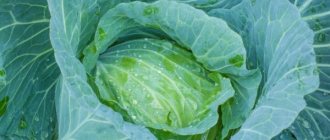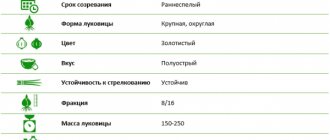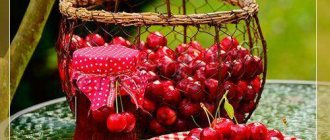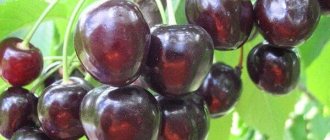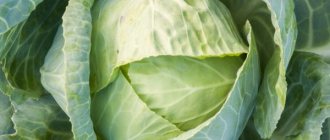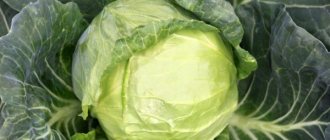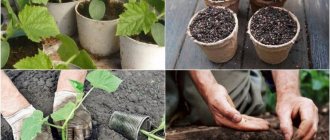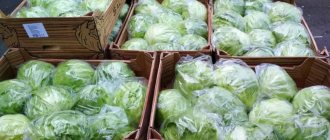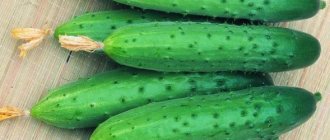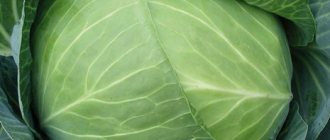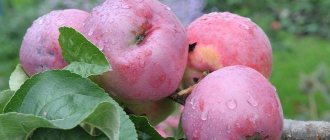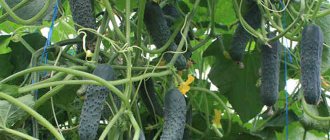The cabbage variety Slava is a mid-season variety. This hybrid was previously grown only in the Non-Black Earth regions, but now it has become popular in other areas where summers are drier. The variety has an excellent taste and an attractive appearance, but these are not its only advantages. The characteristics of Slava cabbage will be of interest to gardeners who are not yet familiar with this wonderful hybrid of domestic selection.
Cabbage variety Slava 1305
Description of variety 1305
Slava 1305 (Brassica oleracea var. capitata) – white cabbage. The variety was bred a long time ago and has an average ripening period. It takes 130 days from emergence to harvest. The variety has good shelf life, is resistant to cracking and produces a yield of up to 12 kg per 1 square meter of area.
Cabbage Slava - characteristics:
- the diameter of the head of cabbage reaches 25 cm;
- round, slightly flattened shape;
- the weight of the head of cabbage reaches 4.5 kg;
- the upper leaves have a light green tint;
- the flesh is almost white.
Planting in open ground
Cabbage Slava (photos attached) grows best in slightly acidic soils.
Future cabbage beds are prepared in the fall - they are dug up and fertilized with humus or manure.
When the cabbage seedlings grow to 15 cm and have 5 leaves (about a month from the date of sowing the seeds), the cabbage is planted in open ground. The beds must first be watered. It is advisable to add 1 tsp of urea and 2 tbsp into the wells for seedlings. l superphosphate. Planting pattern 60x60 cm - the distance between sprouts for the full formation of a head of cabbage is 60 cm.
Photo
Look at the photo below to clearly understand what this variety looks like in order to distinguish it from others.
Distinctive features
This variety is very different from the others in the following characteristics:
- unpretentious in agricultural technology;
- resistant to diseases and pest attacks;
- tolerates lack of moisture well;
- high productivity;
- versatility in use;
- long storage period.
On a note. In addition, thanks to the shape of the head and the structure of the leaves, Slava cabbage is not susceptible to cracking. Therefore, it withstands transportation perfectly.
Market traders are very fond of this variety of cabbage, since the head of cabbage retains its presentation for more than three months, if properly stored. When grown on a personal plot, every gardener can enjoy salad from fresh cabbage until winter.
Blackleg
This disease, like cabbage clubroot, is fungal in nature. The root part of the cabbage leg begins to thin and turn black. As a result of this disease, the plant dies.
Prevention of blackleg is:
- do not allow excessive watering;
- do not allow the plant to thicken;
- Before transferring seedlings to open soil, it must be shed with a solution of potassium permanganate.
Downy mildew
This disease is characterized by the appearance of characteristic yellow spots on the plant. An unpleasant white coating can be found on the bottom of the leaves. This disease can be prevented by standing the seeds in warm water before planting. In such a situation, the following remedies will help:
- spraying cabbage heads with copper sulfate;
- During the growing season, pollinate the plant 3 times with crushed sulfur.
Insects
The most common pest of cabbage leaves is aphids. Affected by these insects, the leaves become light and begin to curl. Sowing dill or parsley next to cabbage beds will protect them well from this annoying insect.
Advantages and disadvantages
Initially, the variety of this cabbage was bred for the non-chernozem part of our country, since it plays an important role for Russia. In many reference books describing Slava 1305 you can read exactly this information in the description of the variety. In these areas, the soil is poorly saturated with humus, but it rains very often, which contributes to the rapid ripening of the crop. But over time, it became clear that Slava tolerates dry periods well, so it began to be grown in all regions.
The advantages include indicators such as:
resistance to low temperatures;
- practically does not form flower stalks;
- excellent taste in any form;
- high yield.
Like any crop, Slava cabbage has its downsides:
- high susceptibility to root system disease - clubroot;
- often affected by vascular bacteriosis;
- it cannot resist Fusarium wilt.
But if you choose and prepare the seeds for planting correctly, treating them with modern preparations, then these troubles can be avoided.
Similar varieties
Let's consider mid-season varieties of white cabbage, which have the same characteristics as Slava in terms of yield and taste.
Belorusskaya 455
An ancient and quite popular variety. It is stored for a long time, does not crack and has good taste when fermented. The weight of one fork reaches 4 kg, the mass is dense and tasty.
Hope
Cabbage was bred by domestic breeders and is very productive. Biological maturity occurs at the end of August, harvesting occurs at the onset of the first frost. Long shelf life - until February. Fork weight – 3.5 kg. per square meter of area you can collect up to 12 kg.
Rinda F1
The hybrid is sectioned in Holland. This mid-season variety can be stored for a long time directly on the vine. It has white-yellow inner leaves. The variety is universal, good both fresh and prepared. The average yield is 9 kg per square.
Present
The variety was bred in 1960. A distinctive feature of the Podarok variety is resistance to diseases. The heads of cabbage reach 4.5 kg, are dense and do not crack. Suitable for pickles. From a square you can collect 10-11 kg.
Megaton F1
A productive, mid-season hybrid of Dutch breeders (read about other varieties of cabbage of Dutch selection here). Resistant to all types of diseases to which cabbage is exposed. Tolerates light frosts. A high-yielding variety, since with proper agricultural technology the heads of cabbage can grow up to 10 kg. It stores well until February and has an excellent presentation (what other varieties are suitable for winter storage?).
Harvesting
Slava can be cut when the weight of the head reaches 0.5 kg. This happens in the second half of July. Harvesting may take two weeks or more. If the stalk is left in the ground after cutting the fruit, then by autumn small heads of cabbage will form on it, which are suitable for eating.
After harvesting, the cabbage should be dried and the damaged top leaves should be torn off. Some of the fruits can be fermented, the rest can be stored in the cellar. The storage room should also be dry; treating the walls and shelves with an antiseptic will prevent the formation of mold and rotting.
Heads of cabbage of medium size, medium-sized, dry, without visible damage, without cracks are best stored. When storing cabbage, you should not mix several varieties, since the fruits have different shelf life, and the rotting area can spread to neighboring heads of cabbage. Optimal humidity is 90–95%, temperature is 0°C; in warmer air the cabbage will begin to germinate, and in low air it will freeze, and when thawed the core will darken.
Methods for storing cabbage in the cellar
- Hanging - for this method you need to leave the stalks with roots. Drive nails into the timber under the ceiling and hang the heads of cabbage on them with their roots up so that they do not touch each other.
- In boxes - cut off all the stalks and put them in boxes with holes.
- Pyramid - place heads of cabbage on a wooden stand in a checkerboard pattern, large ones at the bottom, small ones at the top.
- Under the sand, place the cabbage in boxes, cover each layer with sand.
- In paper or film - wrap each head of cabbage in several layers of paper (it’s better not to use newspaper) or cling film.
How to distinguish from other species?
Important! It is very difficult to distinguish the seeds of one cabbage variety from another. Do not purchase planting material from your own hands; it is better to go to a special store to buy it.
Examine the packaging carefully; it should be marked with an expiration date and the grade must be determined. It must be remembered that the shelf life of seeds cannot exceed 4 years. It is better not to buy expired seeds, as they may simply not germinate.
If cabbage is bought at the market as ready-made seedlings, then you can only distinguish whether it is an early variety or a late one. For example, in early varieties the leaves are almost emerald in color, and their bushes are small and squat.
Late varieties, which include cabbage Slava, have a darker, slightly bluish color of foliage, which is located on an elongated bush.
Read more about types of cabbage here.
There is a huge variety of cabbage varieties: Vestri F1, Nozomi, Romanesco, Kale, Mirror F1, Centurion F1, Kolobok, Sugarloaf, Moscow late, Valentina.
Enemy #1 – Clubroot
This disease is the most common in the described culture, the cause of which is a fungus. Obvious signs of the onset of the disease will be the appearance of compactions on the root system. If this scourge is not recognized or treated in time, root rot will occur. Purely externally, this trouble manifests itself as abnormal development of the sprout.
To prevent the appearance of clubroot, certain measures are needed in the form of competent weeding of cabbage beds, removal of all weeds from the planting area after the heads of cabbage are harvested
It is important to destroy large debris outside the garden and city. It is also recommended to add slaked lime to the soil when sowing.
15 days before planting, soil treatment is carried out using formaldehyde.
Be sure to follow the rules of crop rotation. The place where the cabbage lived a year later will no longer be suitable for it this year.
We emphasize that if the disease has spread to young crops, then, unfortunately, they should be eliminated, since they cannot be treated. But if you follow all the listed prevention rules, growing Slava cabbage will take place without clubroot infestation.
What is it used for?
This variety of cabbage is widely used due to its excellent taste , for example:
- Fresh cabbage is used to make various salads; it can be fried and stewed with various ingredients. The variety of salads will ensure that you will not repeat it even once during the entire growing season.
- Cabbage is good in borscht and pickles; it makes cabbage soup that tastes great.
- Slava makes excellent salads for the winter; it is pickled, fermented, and also used for pickling.
Our ancestors used cabbage not only as food, but also as medicine. For example, cabbage leaves were used to wrap sore joints. And the steamed vegetable was used to treat stomach and intestinal colic. It's no secret that sauerkraut juice is used as a drink after wild parties to relieve hangover symptoms.
Every year, gardeners come up with new ways and recipes that include this healthy and tasty product.
Cabbage care
Young seedlings must be protected from frost. To protect against the cold, use a film or other covering material. You can also water the beds - wet soil retains heat better than dry soil.
Slava cabbage needs to be watered 6-8 times throughout the season. Irrigation requires a significant water consumption - 20 l/sq.m. If you water more often, the heads of cabbage may crack. After each watering it is necessary to hill it up.
The first feeding is done after 15 days. To fertilize, add a cup of mullein to 10 liters of water and leave for a week. This amount should be enough for five cabbage bushes.
With the beginning of the formation of heads of cabbage, it is necessary to fertilize again, adding wood ash to the specified composition. After three weeks, repeat the procedure.
